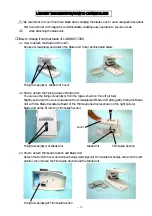
42
DSM300 Installation Manual
2. Cut a hole from outside the hull:
Fiberglass or wood hull – Use a 2" (51 mm) hole saw.
Aluminium or steel hull – Use a 2-1/8" (54 mm) hole saw to accommodate the
isolation sleeve used to prevent contact between the stainless steel housing
and the metal hull.
3. Sand and clean the area around the hole, inside and outside, to ensure that
the sealant will adhere properly to the hull. If there is any petroleum residue
inside the hull, remove it with either a mild household detergent or a weak
solvent (alcohol) before sanding.
4. Remove one safety ring, the retaining pin, the cap nut, and the hull nut from
the transducer (see Figure 2-13 ).
Figure 2-13: Seating
Dry Fit for Fairing
CAUTION:
If a fairing is used, the anti-rotation bolt must be installed to
prevent the fairing from rotating when the boat is underway.
1. Dry fit the transducer to locate the hole for the anti-rotation bolt.
2. Thread the transducer cable through the large hole in the fairing and through
the mounting hole in the hull. Seat the transducer firmly in the recess in the
fairing.
Note:
The transducer must be flush with the fairing. If it is recessed more than 1/64"
(0.5mm) inside the fairing, you may carefully file or sand the fairing flush with the transducer.
Marine
sealant
Retaining pin
Safety ring
Cap nut
Stem
Hull nut
Backing
block
Hull
Fairing
D5566-1
















































